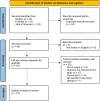A scoping review and modelling of predictors of an abnormal Thompson score in term neonates in low-resource settings
- PMID: 40210710
- PMCID: PMC11986035
- DOI: 10.1038/s41598-025-96566-7
A scoping review and modelling of predictors of an abnormal Thompson score in term neonates in low-resource settings
Abstract
Clinical risk scores, such as Thompson score, are useful alternatives to identify neonatal encephalopathy in low-resource settings where adequate training and equipment are often unavailable. An understanding of the clinical predictors of abnormally high Thompson score values would be beneficial to identify term neonates with suspected neonatal encephalopathy. A scoping review was conducted to identify a set of a priori neonatal and maternal variables associated with neonatal encephalopathy. Next, a prospective study of all term neonates admitted to Sally Mugabe Central Hospital in Zimbabwe between October 2020 and December 2022 was conducted to develop a predictive statistical model of abnormal (> 10) Thompson score. In total 45 articles were identified from searching Medline, Scopus and Web of Science and 10 articles were selected. Five studies were conducted in countries in Asia and five in Africa. Of 6,054 neonates who met the inclusion criteria, 4.06% (n = 246) had an abnormal Thompson score at admission with a case fatality rate of 589 per 1000 admissions. Among these neonates, 90.65% (n = 223) had a low Apgar score (p < 0.001). 40 candidate predictors were identified, of which 20 predictors were selected as the most important. Six risk factors were predictive of neonates at risk of abnormal Thompson score, including low neonatal heart rate (aOR = 0.97), temperature lower than 36.5 °C (aOR = 2.24), head swelling (aOR = 2.19), other maternal risk factors of sepsis excluding offensive liquor and premature rupture of membranes (aOR = 1.97), meconium-stained umbilicus (aOR = 1.79), and not crying at birth (aOR = 2.58). These identified risk factors should be prioritised before conducting a Thompson score assessment in resource-poor settings, and local clinical guidelines should incorporate these into the clinical management of at-risk neonates.
Keywords: LMIC; Low-resource settings; Neonatal encephalopathy; Newborn care; Predictive modeling.
© 2025. The Author(s).
Conflict of interest statement
Declarations. Competing interests: The authors declare no competing interests.
Similar articles
-
Risk factors of mortality in neonates with neonatal encephalopathy in a tertiary newborn care unit in Zimbabwe over a 12-month period.PLOS Glob Public Health. 2022 Dec 20;2(12):e0000911. doi: 10.1371/journal.pgph.0000911. eCollection 2022. PLOS Glob Public Health. 2022. PMID: 36962805 Free PMC article.
-
Factors associated with the admission of moderate to late preterm and term neonates within 72 hours of birth at Dedza and Mangochi District Hospitals, Malawi: a matched case-control study.BMC Pediatr. 2024 Dec 4;24(1):794. doi: 10.1186/s12887-024-05294-w. BMC Pediatr. 2024. PMID: 39633347 Free PMC article.
-
Predictors of neonatal sepsis in public referral hospitals, Northwest Ethiopia: A case control study.PLoS One. 2020 Jun 24;15(6):e0234472. doi: 10.1371/journal.pone.0234472. eCollection 2020. PLoS One. 2020. PMID: 32579580 Free PMC article.
-
Risk factors for neonatal sepsis in Sub-Saharan Africa: a systematic review with meta-analysis.BMJ Open. 2022 Sep 1;12(9):e054491. doi: 10.1136/bmjopen-2021-054491. BMJ Open. 2022. PMID: 36253895 Free PMC article.
-
The assessment of general movements in term and late-preterm infants diagnosed with neonatal encephalopathy, as a predictive tool of cerebral palsy by 2 years of age-a scoping review.Syst Rev. 2021 Aug 12;10(1):226. doi: 10.1186/s13643-021-01765-8. Syst Rev. 2021. PMID: 34384482 Free PMC article.
References
-
- . Standards for improving the quality of care for small and sick newborns in health facilities [Internet]. [cited 2023 Nov 30]. Available from: https://www.who.int/publications-detail-redirect/9789240010765 (2023).
-
- Liang L, Kotadia N, English L, Kissoon N, Ansermino JM, Kabakyenga J, et al. Predictors of mortality in neonates and infants hospitalized with sepsis or serious infections in developing countries: A Systematic Review. Front. Pediatr. [Internet]. [cited 2023 Nov 30];6. Available from: 10.3389/fped.2018.00277 (2018). - PMC - PubMed
-
- Volpe, J. J. Neonatal encephalopathy: an inadequate term for hypoxic–ischemic encephalopathy. Annals of neurology72(2), 156-166 (2012). - PubMed
Publication types
MeSH terms
Grants and funding
LinkOut - more resources
Full Text Sources
Miscellaneous


